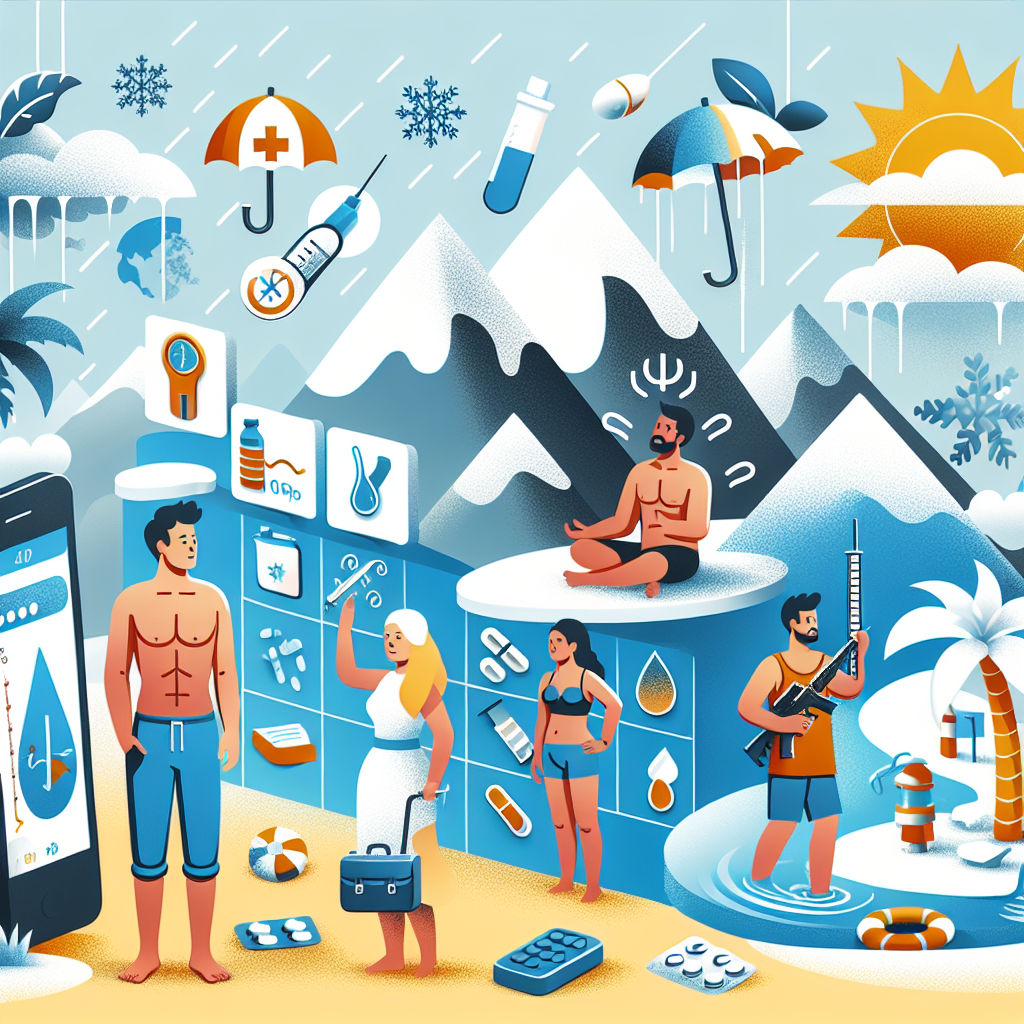Whether you’re heading to a tropical paradise or a snowy wonderland, traveling to different climates with diabetes can present unique challenges. From managing fluctuations in blood sugar levels to navigating medication storage, it’s essential to be prepared and informed. In this article, we’ll explore some practical tips and strategies that can help you stay on top of your diabetes management while enjoying your travel adventures. So pack your bags, grab your glucose meter, and let’s embark on a journey of traveling in different climates with diabetes.
Understanding the Impact of Climatic Changes on Diabetes
Traveling in different climates can have a significant impact on individuals with diabetes. The fluctuations in temperature, humidity, and altitude can affect blood glucose levels, insulin absorption, and hydration levels, making it essential for those with diabetes to be well prepared. This article aims to provide a comprehensive understanding of the impact of climatic changes on diabetes and offer practical tips to manage the condition while traveling to various climates.
The effect of high temperatures on glucose levels
Hot climates can pose challenges for individuals with diabetes, as high temperatures can lead to dehydration and affect blood glucose control. When it’s hot, the body sweats more to cool down, leading to increased fluid loss. This can result in elevated blood glucose levels, especially if sufficient hydration is not maintained. Therefore, it is crucial to stay well-hydrated by drinking plenty of water and avoiding sugary drinks. Monitoring blood glucose levels more frequently and adjusting insulin doses accordingly can help manage glucose levels effectively in hot climates.
The role of cold weather in insulin absorption
Cold weather can impact insulin absorption, making it necessary for individuals with diabetes to understand how to manage their insulin effectively in colder climates. Cold temperatures can cause vasoconstriction, reducing blood flow to the injection site and potentially affecting the rate of insulin absorption. To overcome this, it is recommended to warm the insulin vial or pen in your hands before administering the injection. Additionally, wearing appropriate clothing to keep the body warm and protecting insulin supplies from freezing is crucial in cold weather.
Impact of humidity on hydration levels for diabetics
Humid climates can affect hydration levels for individuals with diabetes. High humidity can make it harder for the body to cool down through sweating, leading to increased fluid loss and potentially contributing to dehydration. People with diabetes are more prone to dehydration as elevated blood glucose levels can cause increased urination. It is essential to be mindful of maintaining hydration levels by drinking enough water and avoiding excessive intake of sugary and caffeinated beverages. Monitoring blood glucose levels and adjusting insulin doses as needed is also crucial in humid climates.
Pre-departure Preparations
Before embarking on your trip, it is essential to make necessary preparations to ensure a smooth and safe travel experience.
Researching about your destination’s climate
Researching the climate of your travel destination is a crucial first step. Understanding the typical weather patterns, temperature ranges, and humidity levels will help you plan accordingly. Knowing what to expect can guide you in making informed decisions about your clothing, insulin storage, and overall diabetes management during your trip.
Adjustment of insulin doses before travel
Consulting with your healthcare provider before your trip is essential, as they can provide guidance on adjusting your insulin doses based on your destination’s climate. Cold weather may require higher insulin doses, while hot weather may necessitate lower doses due to increased activity and fluid intake. It’s important to remember that everyone’s insulin needs are unique, so working closely with your healthcare team is crucial.
Packing the appropriate clothing
Packing the right clothing is essential to stay comfortable and maintain optimal diabetes management while traveling. For hot climates, lightweight and breathable clothing is recommended to help regulate body temperature and prevent overheating. In cold climates, layering is key to insulating body heat. It’s advisable to pack extra layers, thermal socks, and gloves to protect against the cold. Remember to bring sturdy and comfortable footwear suitable for the terrain and climate of your destination.

Traveling to Hot Climates with Diabetes
Traveling to hot climates requires extra precautions to manage diabetes effectively and stay safe and healthy.
Understanding the danger of dehydration
Dehydration is a significant concern in hot climates, as excessive heat and sweating can lead to fluid loss. For individuals with diabetes, this can pose an even greater risk, as dehydration can cause blood glucose levels to rise. It is essential to maintain proper hydration by drinking plenty of water throughout the day. Avoiding sugary and caffeinated beverages is recommended, as they can contribute to further fluid loss.
Managing insulin storage in hot temperatures
Insulin is sensitive to heat, and exposure to high temperatures can affect its efficacy. When traveling to hot climates, it is crucial to store insulin properly to maintain its potency. Insulin should be kept in a cool place, away from direct sunlight. Using a travel cooler or insulated pouch can help keep insulin at the recommended temperature range. It is also advisable to carry extra insulin supplies to ensure you have an adequate amount throughout your trip.
Tips to avoid foot-related complications in hot climates
Hot climates can increase the risk of foot-related complications for individuals with diabetes. Sweaty feet can lead to fungal infections and blisters, which can be particularly troublesome for those with reduced sensitivity due to neuropathy. It is important to wear breathable footwear, change socks regularly, and keep feet dry to prevent fungal growth. Applying sunscreen to the feet and using sandals or open-toe shoes when appropriate can also help prevent blisters and keep feet cool.
Traveling to Cold Climates with Diabetes
Traveling to cold climates requires additional considerations to ensure diabetes management is not compromised.
Avoiding hypothermia for diabetics
Diabetics are at a higher risk of hypothermia in cold climates due to impaired circulation and reduced ability to sense temperature changes in extremities. To avoid hypothermia, it is crucial to dress warmly and layer clothing appropriately. Paying special attention to extremities, such as hands, feet, and ears, is important to prevent frostbite. Keeping the body warm and maintaining adequate blood circulation can help reduce the risk of hypothermia.
Keeping insulin supplies safe from freezing
Insulin can freeze in extremely cold temperatures, rendering it ineffective. It is essential to protect insulin supplies from freezing when traveling to cold climates. Storing insulin in an insulated travel pouch or cooler can help maintain its temperature within the recommended range. It is also advisable to carry insulin in your hand luggage to prevent exposure to extreme cold in checked baggage.
Special foot care in cold climates
Cold weather can be harsh on the feet, especially for individuals with diabetes who may have reduced blood circulation and sensation in their lower extremities. To prevent foot-related complications, it is important to keep feet warm and dry. Wearing insulated and waterproof shoes, thermal socks, and using moisturizing cream can help protect the feet from the cold and prevent dryness and cracking.

Traveling to Humid Climates with Diabetes
Journeying to humid climates requires specific measures to ensure proper diabetes management and avoid potential complications.
Importance of maintaining hydration levels
Maintaining hydration is crucial in humid climates, as excessive humidity can make it harder for the body to cool down, leading to more significant fluid loss. For individuals with diabetes, this can result in increased blood glucose levels. It is important to drink plenty of water throughout the day and avoid sugary and caffeinated drinks, which can contribute to dehydration. Monitoring blood glucose levels closely and adjusting insulin doses as needed is key to maintaining stable glucose control in humid environments.
Managing skin complications due to excess moisture
Humid climates can contribute to skin issues, including fungal infections and skin irritation, due to excess moisture. It is important to keep the skin clean and dry to prevent these complications. Wearing breathable clothing made from moisture-wicking fabrics can help absorb excess sweat and reduce the risk of skin problems. Applying talcum powder or antifungal creams in areas prone to moisture buildup, such as the groin and underarms, can also help prevent skin irritations.
Insulin storage recommendations in humid conditions
Humidity can affect insulin storage, potentially reducing its effectiveness. When traveling to humid climates, it is crucial to store insulin properly to maintain its potency. Insulin should be kept in a cool place, away from direct sunlight and excessive moisture. Using an insulated travel pouch or cooler can help regulate temperature and humidity levels, ensuring the insulin remains within the recommended range. Additionally, it is essential to have spare insulin supplies to prevent running out during the trip.
Traveling to High Altitude Locations with Diabetes
Traveling to high-altitude locations presents unique challenges for individuals with diabetes. Adequate preparation is necessary to ensure good diabetes management in these environments.
Effects of high altitude on blood glucose levels
High-altitude environments can significantly impact blood glucose levels. Reduced oxygen levels can trigger the release of stress hormones, such as adrenaline, which can cause temporary insulin resistance. This, combined with increased physical activity at higher altitudes, can lead to unpredictable changes in blood glucose levels. Monitoring blood glucose frequently and adjusting insulin doses in consultation with your healthcare provider is crucial in maintaining stable blood sugar control at high altitudes.
Tips for diabetic management at high altitudes
Managing diabetes at high altitudes requires careful monitoring and adjustments in diabetes management strategies. It is essential to stay well-hydrated by drinking plenty of fluids, as high altitudes can cause increased fluid loss through increased respiration and urination. Being mindful of altitude sickness symptoms such as headache, dizziness, and shortness of breath, and seeking medical help if needed, is crucial to ensure your health and safety.
Adjusting insulin doses at higher altitudes
The need for insulin may change at higher altitudes due to increased physical activity, metabolic changes, and the body’s response to reduced oxygen levels. Consulting with your healthcare provider to adjust insulin doses before and during your trip is essential to maintain stable blood glucose control. It is advisable to carry extra insulin supplies to account for any unforeseen changes in dosage requirements.

Dietary Considerations in Different Climates
Diet plays a crucial role in managing diabetes regardless of the climate you’re traveling to. However, different climates may require specific dietary considerations to ensure optimal blood sugar control.
Maintaining blood sugar balance in hot climates
In hot climates, it is important to be mindful of the types of food you consume to maintain blood sugar balance. Opting for lighter, low-glycemic index foods can help prevent rapid spikes in blood glucose levels. Foods such as fresh fruits, vegetables, whole grains, and lean proteins are good choices. It is also advisable to limit the intake of sugary and high-fat foods, as they can lead to greater fluctuations in blood sugar levels.
Caloric requirements in cold climates
Cold climates can increase the body’s energy requirements to keep warm. Individuals with diabetes should be aware of their increased caloric needs to maintain stable blood sugar levels and energy levels. Incorporating warmer, nutrient-dense foods such as soups, stews, and hot beverages can help meet these needs. It is important to ensure a balanced diet that includes carbohydrates, proteins, and healthy fats to support overall health and diabetes management.
Hydration needs in humid climates
Staying well-hydrated is crucial in humid climates, as excessive heat and humidity can lead to increased fluid loss. Drinking plenty of water throughout the day is important to maintain hydration. However, it is advisable to monitor blood glucose levels and adjust fluid intake accordingly, especially if blood glucose levels are elevated. It is also essential to avoid sugary and caffeinated beverages, as they can contribute to further fluid loss.
Activity Levels and Exercise in Different Climates
Engaging in physical activity and exercise is important for overall health, regardless of the climate. However, when traveling in different climates, it is vital to exercise caution and adapt your routines accordingly.
Exercise caution in extreme weather conditions
Extreme weather conditions, such as high temperatures or extreme cold, require caution when engaging in physical activity. It is important to avoid exercising during the hottest times of the day in hot climates and to seek shade and cool down frequently. In cold climates, it is crucial to dress warmly, especially during outdoor activities, to prevent hypothermia. Monitoring blood glucose levels before, during, and after exercise is important, as different climates may impact the body’s glucose response.
Significance of warming up and cooling down in cold climate
In colder climates, warming up before exercise and cooling down afterward are particularly important. Cold temperatures can cause muscles to become stiff and increase the risk of injury. Engaging in light aerobic activities or dynamic stretching before exercise helps warm up the body and increase blood flow to the muscles. After exercise, a proper cool-down routine, including stretching and gradual decrease in intensity, helps prevent muscle tightness and enhance recovery.
Preserving energy in hot and humid climates
In hot and humid climates, it is essential to preserve energy and prevent overheating during physical activity. Opting for exercise routines during the cooler parts of the day, such as early morning or late afternoon, can help avoid excessive heat exposure. Choosing activities that are less strenuous and reduce the risk of overheating, such as swimming or water aerobics, is recommended. Drinking plenty of fluids and taking breaks to rest and cool down are crucial to prevent dehydration and heat-related complications.

Medical Considerations and Healthcare Access
Access to appropriate healthcare and medical considerations are vital for individuals with diabetes while traveling to different climates.
Knowing the nearest healthcare facilities
Before traveling, it is important to research and be aware of the nearest healthcare facilities at your travel destination. Knowing where the closest hospitals or clinics are can provide peace of mind in case of any medical emergencies that may arise. It is also advisable to carry a list of emergency contact numbers and information about your diabetes management, such as your healthcare provider’s name and contact details.
Ensuring international insurance coverage
Traveling with international medical insurance coverage is crucial, as it can provide financial protection and access to necessary medical care while abroad. Understanding the extent of your coverage, including emergency medical evacuation, medication coverage, and pre-existing condition coverage, is essential. Carrying a copy of your insurance documentation and emergency contact information is advisable.
Travel vaccination advice for diabetics
Diabetics should consult with their healthcare provider or travel medicine specialist regarding necessary vaccinations before traveling to different climates. Some destinations may require specific vaccinations, and it is important to receive them in a timely manner. Vaccinations can help prevent infectious diseases and protect your overall health while traveling. Additionally, those with diabetes should ensure they have an ample supply of any routine or emergency medications before embarking on their trip.
Key Takeaways for Traveling In Different Climates With Diabetes
Traveling in different climates with diabetes requires careful planning, preparation, and an understanding of how climate changes can affect your condition. By following these key takeaways, you can ensure a safe and enjoyable trip:
Importance of advance planning
Research your destination’s climate, make necessary adjustments to your diabetes management plan, and pack appropriate clothing and supplies for the climate you will be traveling to.
Understanding the body’s responses to different climates
Be aware of how changes in temperature, humidity, and altitude can impact your blood glucose levels, insulin absorption, and hydration levels. Monitor your blood glucose frequently and adjust your insulin doses as needed.
Ensuring good diabetes management whatever the weather
Stay well-hydrated, protect your insulin supplies, take care of your feet, and maintain a balanced diet to support your diabetes management regardless of the climate. Take precautions when engaging in physical activity and be aware of the availability of healthcare facilities and your insurance coverage. With proper planning and attention to your diabetes needs, you can enjoy your travels while keeping your diabetes well-managed.


